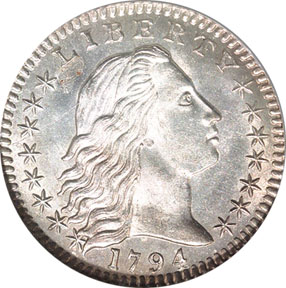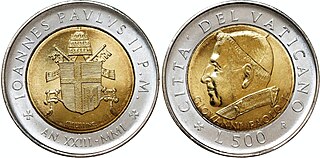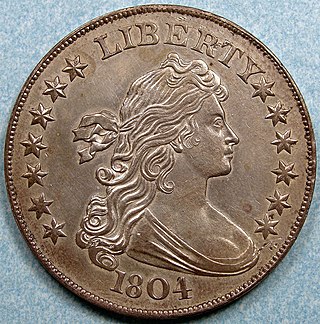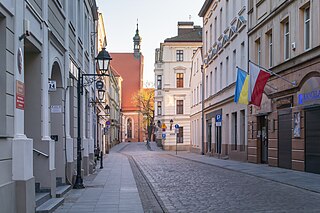
The Polish złoty is the official currency and legal tender of Poland. It is subdivided into 100 grosz (gr). It is the most-traded currency in Central and Eastern Europe and ranks 21st most-traded in the foreign exchange market.

Bydgoszcz is a city in northern Poland and the largest city in the historical region of Kuyavia. Straddling the confluence of the Vistula River and its left-bank tributary, the Brda, the strategic location of Bydgoszcz has made it an inland port and a vital centre for trade and transportation. With a city population of 339,053 as of December 2021, Bydgoszcz is the eighth-largest city in Poland. Today, it is the seat of Bydgoszcz County and one of the two capitals of the Kuyavian-Pomeranian Voivodeship as a seat of its centrally appointed governor, a voivode.
A circulation issue or circulation coin, sometimes called a business strike (US), is a coin minted and issued for commerce as opposed to those made as commemorative coins and proof coins. Circulation issue coins are normally produced in relatively large numbers, and are primarily meant to be used as pocket change, not collected. But after their withdrawal from circulation, these coins are highly valued by collectors, especially coins of high quality and without traces of use in trade. Preserved circulation coins are one of the primary sources by which scientists reconstruct the culture, history, and society of the time in which they were used.

The 1933 double eagle is a United States 20-dollar gold coin. Although 445,500 specimens of this Saint-Gaudens double eagle were minted in 1933 in the midst of the Great Depression, none were ever officially circulated, and all but two were ordered to be melted down. However, 20 more are known to have been rescued from melting by being stolen and found their way into the hands of collectors before later being recovered. Nine of the recovered coins were destroyed, making this one of the world's rarest coins, with only 13 known specimens remaining—only one of which is privately owned, which is known as the Weitzman Specimen. Because the coin was never released to the public, it is illegal to privately own any of the 1933 double eagles, with the exception of the Weitzman Specimen. The United States Secret Service is said to investigate reports of the existence of other specimens that come to light.

A double eagle is a gold coin of the United States with a denomination of $20. The coins are 34 mm × 2 mm and are made from a 90% gold and 10% copper alloy and have a total weight of 1.0750 troy ounces.

In Canada, a dime is a coin worth ten cents. It has been the physically smallest Canadian coin since 1922; it is smaller even than the country's penny, despite its higher face value. According to the Royal Canadian Mint, the official national term of the coin is the 10-cent piece, but in practice, the term dime predominates in English-speaking Canada. It is nearly identical in size to the American dime. Unlike its American counterpart, the Canadian dime is magnetic due to a distinct metal composition. From 1968 to 2000, it was composed entirely of nickel, and since 2001, it has consisted of a steel core with plating composed of layers of nickel and copper.

The half dime, or half disme, was a silver coin, valued at five cents, formerly minted in the United States.

The ducat coin was used as a trade coin in Europe from the later Middle Ages to the 19th century. Its most familiar version, the gold ducat or sequin containing around 3.5 grams of 98.6% fine gold, originated in Venice in 1284 and gained wide international acceptance over the centuries. Similarly named silver ducatons also existed. The gold ducat circulated along with the Florentine florin and preceded the modern British pound sterling.

In Canada, a penny is an out-of-production coin worth one cent, or 1⁄100 of a dollar. According to the Royal Canadian Mint, the official term for the coin is the one-cent piece, but in practice the terms penny and cent predominate. Penny was likely readily adopted because the previous coinage in Canada was the British monetary system, where Canada used British pounds, shillings, and pence as coinage alongside U.S. decimal coins. Like all Canadian coins, the obverse depicts the reigning Canadian monarch at the time of issue.

The United States four dollar coin, also officially called a Stella, is a unit of currency equivalent to four United States dollars.

The lira was the currency of the Vatican City between 1929 and 2002. It was not a separate currency but an issue of the Italian lira; the Banca d'Italia produced coins specifically for Vatican City.

The 1913 Liberty Head nickel is an American five-cent piece which was produced in extremely limited quantities unauthorized by the United States Mint, making it one of the best-known and most coveted rarities in American numismatics. In 1972, one specimen of the five cent coin became the first coin to sell for over US$100,000; in 1996, another specimen became the first to sell for over US$1 million. A specimen was sold for US$3 million in a 2004 private sale, then resold for US$3.7 million at a public auction in 2010.

The 1894-S Barber dime is a dime produced in the United States Barber coinage. It is one of the rarest and most highly prized United States coins for collectors, along with the 1804 dollar and the 1913 Liberty Head nickel. One was sold in 2005 for $1.3 million, and another for $1.9 million in 2007. Only 24 were minted, and of those, only nine are known to survive; all nine were proof coins; two are heavily worn impaired proofs. In 1957, one of the latter was found in a junk coin box at Gimbels Department Store, and purchased for $2.40.

Quentin David Bowers is an American numismatist, author, and columnist. Beginning in 1952, Bowers’s contributions to numismatics have continued uninterrupted and unabated to the present day. He has been involved in the selling of rare coins since 1953 when he was a teenager.

The 1804 dollar or Bowed Liberty Dollar was a dollar coin struck by the United States Mint, of which fifteen specimens are currently known to exist. Though dated 1804, none were struck in that year; all were minted in the 1830s or later. They were first created for use in special proof coin sets used as diplomatic gifts during Edmund Roberts' trips to Siam and Muscat.

Mill Island is a historic area located in the Old Town of Bydgoszcz, Poland, covering approximately 6.5 ha: today it is a place with cultural and recreational facilities, surrounded by the Brda river and its branch. The island received the 2012 certificate for Best Tourist Attraction from the Polish Tourist Organisation.
The 1851 Humbert $50 gold ingot was an Ingot produced by Moffat and Company, under the direction of Augustus Humbert This "coin", while technically an ingot, was still used and unofficially considered currency. It was also the largest ingot produced during the California Gold Rush, weighing almost 2.5 oz.

Jezuicka Street is a street located in Bydgoszcz, Poland. Many of its buildings are either registered on Kuyavian-Pomeranian Voivodeship heritage list, or part of Bydgoszcz local history.

Bydgoszcz Old Market square is an oblong place, situated in the old town district of the city of Bydgoszcz. The City Hall flanks one of its side, and nearby is located St. Martin and St. Nicholas Cathedral.


















